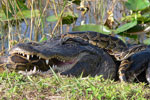
The reticulated python. Photo by Rhett Butler.
Bird conservationists in the United States are urging Congress to ban imports of five types of snakes that are considered a threat to native birds.
In a letter sent the U.S. House Resource Committee, the American Bird Conservancy called for a ban on imports and inter-state trade in reticulated pythons, green anacondas, boa constrictors, and two other constrictor species. The group says the snakes should be listed as “injurious wildlife” under the Lacey Act, a 112-year-old law governing the trade in wildlife and plant products.
“This bill (H.R. 511 –To Prohibit the Importation of Various Injurious Species of Constrictor Snakes) is necessary to prevent the further spread of these aggressive, invasive predators,” said Darin Schroeder, Vice President for Conservation Advocacy at the American Bird Conservancy. “It’s well-established that these snakes are highly adaptable to new environments, and that they consume a wide variety of prey, including mammal, amphibian, lizard, and threatened and endangered bird species.”

Boa constrictor in Colombia. Photo by Rhett Butler.
The problem with these snakes stems not so much from trade, but from irresponsible pet owners who release them into the wild where they prey on native wildlife. The American Bird Conservancy cited a recent study which found that birds account for a quarter of a typical Burmese python’s diet in the Everglades. Burmese pythons — native to Southeast Asia — are invasive in Florida.
The group also highlighted the large-scale die-off of native birds in Guam after the brown tree snake was introduced. Nine of the island’s 11 native land birds have gone extinct to date. The snakes also caused other problems, including disruption of the island’s power and communications systems. The group warned Hawaii could be next.
“If snakes were to reproduce and proliferate, it quickly may be too late to stop them, and as a result, every measure to keep them out of places like Hawaii needs to be taken,” said Schroder in the letter.
Related articles
Invasion!: Burmese pythons decimate mammals in the Everglades
(01/30/2012) The Everglades in southern Florida has faced myriad environmental impacts from draining for sprawl to the construction of canals, but even as the U.S. government moves slowly on an ambitious plan to restore the massive wetlands a new threat is growing: big snakes from Southeast Asia. A new paper in the Proceedings of the National Academy of Sciences (PNAS) has found evidence of a massive collapse in the native mammal population following the invasion of Burmese pythons (Python molurus bivittatus) in the ecosystem. The research comes just after the U.S. federal government has announced an importation ban on the Burmese python and three other big snakes in an effort to safeguard wildlife in the Everglades. However, the PNAS study finds that a lot of damage has already been done.
U.S. implements snake ban to save native ecosystems

(01/25/2012) Last week the U.S. Fish and Wildlife Service (USFWS) announced it was banning the importation and sale across state lines of four large, non-native snakes: the Burmese python (Python molurus bivittatus), the yellow anaconda (Eunectes notaeus), and two subspecies of the African python (Python sebae). Although popular pets, snakes released and escaped into the wild have caused considerable environmental damage especially in the Florida Everglades.
The dark side of new species discovery

(12/21/2011) Scientists and the public usually rejoice when a new species is discovered. But biologist Bryan Stuart has learned the hard way that the discovery of new species, especially when that species is commercially valuable, has a dark side-one that could potentially wipe out the new species before protections can be put in place. Stuart has discovered 27 species unknown previously to scientists – so far. That includes 22 species of frogs, three types of snakes, and two salamanders. His experience with one of these, a warty salamander from Laos with striking markings (Laotriton laoensis), opened his eyes to a dark side of scientific discovery: commercial overexploitation before protections are in place. Shortly after Stuart described the previously unknown species Paramesotriton laoensis in a scientific paper published in 2002, commercial dealers began collecting this Lao newt for sale into the pet trade. In essence, the dealers used Stuart’s geographic description in the paper as a “roadmap” to find the rare newt.
Florida announces python hunt following snake invasion
(07/16/2009) Florida has authorized a cull of Burmese pythons that have invaded the Everglades and other wetland areas, reports the Associated Press.
Aloha, and welcome to the planet’s extinction capital

(11/07/2011) Hawaii evokes images of a tropical paradise where fragrant flowers, vivid colors, exotic plants, birds, and
fish abound. Unfortunately, much of Hawaii’s original native flora and fauna has disappeared since the
arrival of Europeans in the 18th Century. Hawaii now has the dubious distinction as having become the
planet’s extinction capital, having lost more than 55 endemic species (mostly native forest birds) which
account for nearly one third of recorded of bird extinctions since the 1700s.














